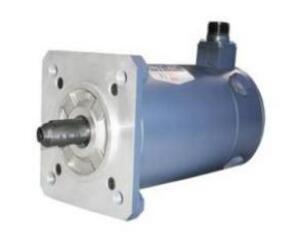
The servo permanent magnet motor is a micro motor used as an execution element in automatic control devices. Its function is to convert electrical signals into the angular displacement or angular velocity of the rotating shaft. Moreover, servo permanent magnet motors are divided into two categories: AC servo and DC servo. Let’s take a look at the comparison of these two categories.
The basic structure of an AC servo permanent magnet motor is similar to an AC induction motor (asynchronous motor). There are two excitation windings Wf and control windings WcoWf with a phase space displacement of 90° on the stator. They are connected to a stable AC voltage and use the AC voltage or phase changes applied to Wc to achieve the purpose of controlling the operation of the motor. AC servo motors have the characteristics of stable operation, good controllability, fast response, high sensitivity, and strict nonlinearity indicators of mechanical characteristics and regulation characteristics (required to be less than 10% to 15% and less than 15% to 25% respectively).
The basic structure of the DC servo permanent magnet motor is similar to that of a general DC motor. Motor speed n=E/K1j=(Ua-IaRa)/K1j, where E is the armature counter electromotive force, K is a constant, j is the magnetic flux of each pole, Ua and Ia are the armature voltage and armature current, Ra is The armature resistance, changing Ua or changing φ, can control the speed of the DC servo motor, but the method of controlling the armature voltage is generally used. In the permanent magnet DC servo motor, the excitation winding is replaced by a magnet, and the magnetic flux φ is stable. DC servo motors have linear regulation characteristics and fast time response.
Advantages and disadvantages of DC servo permanent magnet motor:
Advantages: accurate speed control, very hard torque and speed characteristics, simple control principle, easy to use, and cheap price.
Disadvantages: brush commutation, speed limit, additional resistance, generation of wear particles (not suitable for dust-free and explosive environments).
Advantages and disadvantages of AC servo permanent magnet motor:
Advantages: Excellent speed control characteristics, smooth control in the entire speed zone, al no vibration, high efficiency of more than 90%, less heat generation, high-speed control, high-accuracy azimuth control (depending on the encoder accuracy), extra operating area Within, it can achieve constant torque, low inertia, low noise, no brush wear, and no protection (suitable for dust-free and explosive environments).
Disadvantages: The control is relatively complicated, the driver parameters need to be adjusted on-site to determine the PID parameters, and more connections are required.
DC servo permanent magnet motors are divided into brushed and brushless motors:
Brush motors have low cost, simple structure, large starting torque, wide speed range, simple control, and require maintenance, but they are easy to maintain (replacement of carbon brushes), produce electromagnetic interference, have requirements on the use environment, and are generally used for cost-sensitive applications. general industrial and civil applications.
Brushless motors are small in size and light in weight, with large output and fast response. They have high speed and small inertia, stable and smooth rolling torque, complex and intelligent control, and flexible electronic commutation methods. They can commutate with square waves or sine waves. The motors are free of protection and are highly efficient and energy-saving. , small electromagnetic radiation, low temperature rise and long life, suitable for various environments.
AC servo motors are also brushless motors and are divided into synchronous and asynchronous motors. Nowadays, synchronous motors are generally used in motion control. They have large power scale, can achieve high power, large inertia, low speed, and the speed becomes constant as the power increases. Descending, suitable for low-speed and smooth operation situations.
The rotor inside the servo motor is a permanent magnet. The driver controls the U/V/W three-phase electricity to form an electromagnetic field. The rotor rolls under the effect of this magnetic field. At the same time, the motor's own encoder transmits the response signal to the driver to compare the response value and the target. The value is compared, and then the angle of rotation of the rotor is adjusted. The accuracy of the servo motor is determined by the accuracy (number of lines) of the encoder.



















